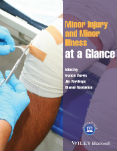-
What is the correct diagnosis for each of the following clinical descriptions?
(a) Large unilateral tonsillar swelling with unremitting fever and pooling of saliva.
(b) Fever, nasal discharge, facial/dental pain and congestion.
(c) Fever, sore throat, drooling and stridor.
(d) Coryza, malaise, high fever (usually >38°C) myalgia, marked lethargy.
Show Answer
Correct answer:
(a) Large unilateral tonsillar swelling with unremitting fever and pooling of saliva.
Quinsy
(b) Fever, nasal discharge, facial/dental pain and congestion.
Sinusitis
(c) Fever, sore throat, drooling and stridor.
Epiglottitis
(d) Coryza, malaise, high fever (usually >38°C) myalgia, marked lethargy.
Influenza
See Chapter 16.
-
2. What are the components of the CRB-65 score?
Show Answer
Correct answer:
- Confusion
- Respiratory rate ≥ 30/min
- Blood pressure ≤90mmHg systolic
- Age ≥ 65years
See Chapter 17.
-
3. What is the significance of a CRB65 score of:
(a) 0; (b) 3; (c) 1 or 2.
Show Answer
Correct answer:
(a) 0
Low risk of death and do not usually require hospital admission
(b) 3
High risk of death and require urgent admission
(c) 1 or 2
Increased risk of dying and referral or early review should be considered
See Chapter 17.
-
4. What are the indications for chest X-ray after trauma?
Show Answer
Correct answer:
- Significant mechanism of injury
- Shortness of breath
- Hypoxia/high respiratory rate
- Suspected haemothorax/pneumothorax
- Elderly patients
- Significant pre-existing chest problems
See Chapter 18.
-
5. Name five types of chest pain.
Show Answer
Correct answer:
- Musculoskeletal
- Myocardial ischaemic pain
- Pleuritic
- Tearing
- Atypical – none of the above
See Chapter 18.
-
6. What is the correct diagnosis for each of the following clinical descriptions?
(a) Periumbilical pain that moves to the right iliac fossa with nausea and anorexia.
(b) Right upper quadrant pain, radiating to back with vomiting.
(c) Severe upper/generalised pain with vomiting.
(d) Severe sudden-onset abdominal or back pain with collapse.
(e) Colicky pain with vomiting and not passing flatus or stool.
(f) Older patient with central/nonspecific pain, often with atrial fibrillation. Minimal or unremarkable abdominal examination.
Show Answer
Correct answer:
(a) Periumbilical pain that moves to the right iliac fossa with nausea and anorexia.
Appendicitis
(b) Right upper quadrant pain, radiating to back with vomiting.
Biliary colic
(c) Severe upper/generalised pain with vomiting.
Pancreatitis
(d) Severe sudden-onset abdominal or back pain with collapse.
Abdominal aortic aneurism
(e) Colicky pain with vomiting and not passing flatus or stool.
Intestinal obstruction
(f) Older patient with central/nonspecific pain, often with atrial fibrillation. Minimal or unremarkable abdominal examination.
Mesenteric ischaemia
See Chapter 19.
-
7. List the common causative organisms for a urinary tract infection.
Show Answer
Correct answer:
- Escherichia coli
- Klebsiella
- Proteus sp.
- Enterobacter sp.
See Chapter 20.
-
8. A 59-year-old man presents with urinary frequency and mild dysuria. A dipstick is positive for haematuria, nitrites and leucocytes. What is your initial management?
Show Answer
Correct answer:
(a) Antibiotics according to local/national guidance
(b) Send urine for microscopy and culture
(c) Arrange follow-up after antibiotic treatment
See Chapter 20.
-
9. On review after 1 week, his symptoms have improved and culture has confirmed a urinary tract infection. What is your management at this point?
Show Answer
Correct answer:
Repeat dipstick. If it shows haematuria, then referral to urology for further investigation
See Chapter 20.
-
10. A young man presents with sudden severe pain in the testes. How do you differentiate between torsion and infection?
Show Answer
Correct answer:
He needs urgent referral to a urologist. It is not safe to diagnose infection as a cause of such symptoms
-
11. A 60-year-old man presents with right loin pain radiating to the groin. What is the differential diagnosis and what investigations are required?
Show Answer
Correct answer:
- The differential diagnosis includes ruptured aortic aneurism and renal colic
- Investigations include careful abdominal examination, strip testing the urine, bloods, including group and save, and a non-contrast abdominal CT
See Chapter 21.
-
12. What investigations would you carry out for a young woman with abdominal pain?
Show Answer
Correct answer:
- Pregnancy test
- Urine dip test
- Ultrasound scan via early pregnancy assessment unit (if pregnant)
See Chapter 22.
-
13. List the symptoms of ectopic pregnancy.
Show Answer
Correct answer:
- Severe abdominal pain
- Mild abdominal pain
- Nausea and vomiting
- Shoulder tip pain
- Dizziness
(Ectopic pregnancy can present in many ways. The classical triad of shock, severe abdominal pain with shoulder pain is present in a minority of cases. Any woman with abdominal pain, even if it is mild, should have a pregnancy test. If the test is positive an ectopic should be suspected)
See Chapter 22.
-
14. What is the correct diagnosis for each of the following clinical descriptions?
(a) Usually present with painless passage of bright red blood into the toilet or on wiping.
(b) Anal pain and usually passage of bright red blood with a purplish swelling at anal verge.
(c) Significant pain on passage of stool which may last up to 1–2 h after. Small amounts of bright red blood may be seen on wiping.
(d) Deep anal pain, worse on sitting or passing stool.
(e) Painful swelling at the natal cleft.
Show Answer
Correct answer:
(a) Usually present with painless passage of bright red blood into the toilet or on wiping.
Uncomplicated haemorrhoids
(b) Anal pain and usually passage of bright red blood with a purplish swelling at anal verge.
Thrombosed haemorrhoid
(c) Significant pain on passage of stool which may last up to 1–2 h after. Small amounts of bright red blood may be seen on wiping.
Anal fissure
(d) Deep anal pain, worse on sitting or passing stool.
Perianal abscess
(e) Painful swelling at the natal cleft.
Pilonidal abscess
See Chapter 23.

